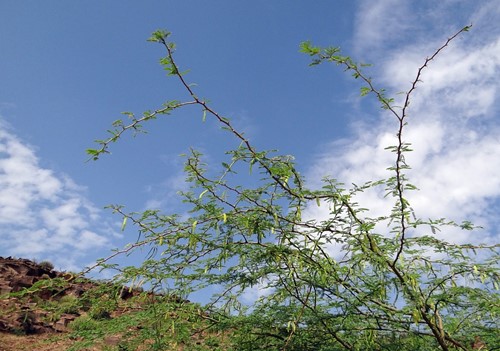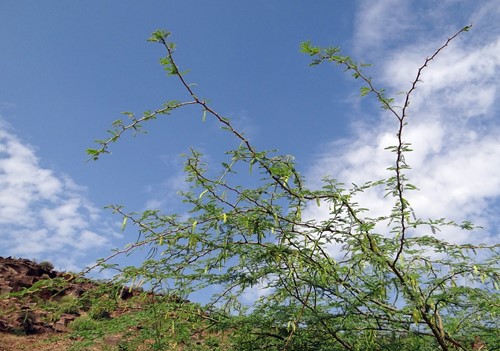Parashat Vayechi: Brothers, But Different

On the difference between Shimon and Levi stemming from different tendencies—to be channeled and tempered in different ways. And about the connection to terumot and ma'aserot and the Syrian mesquite.
"Simeon and Levi are brothers; their weapons are a stolen craft. Let not my soul be included in their council, let not my being be counted in their assembly … cursed be their anger so fierce, and their wrath so relentless. I will divide them in Jacob, scatter them in Israel" (Bereishit 49: 5-7).
"Let not my soul be included in their council" – this refers to the incident with Zimri. "In their assembly" — when Korach, who is from the tribe of Levi, will assemble the congregation against Moshe and Aharon." (Rashi 49:6).
" 'I will divide them in Jacob' … there shall be no poor or scribes or teachers of small children except from [the tribe of] Shimon, so that they will be dispersed. The tribe of Levi was also made to go from one threshing floor to another for offerings (terumot) and tithes (ma'aserot). He caused [Levi] to be dispersed in an honorable way." (Rashi, ibid.: 7).
One Act—Different Consequences
At times, two students do the same thing are given very different punishments. The student who feels he was dealt with unfairly complains to the teacher, accusing him of discrimination. The teacher responds that while the results of the act are the same, the actions stemmed from different roots, so each need to be addressed separately.
Among the sons of Ya'akov there are pairs, where various circumstances tie them together. These include: Yissachar and Zevulun, Yosef and Binyamin, Yosef and Yehuda, Reuven and Yosef. The pair whose fraternity stands out most is Shimon and Levi. Later down the line we do not see that this bond persists; on the contrary, their descendants each fail in different areas, their differences manifesting in the negative historical event tied to each tribe: the sin with the women of Moav and Korach's rebellion; and also in the "punishment" that Yaakov gives each. The tribe of Shimon will be poor teachers while the Levi'im will go to threshing floors to collect terumot and ma'aserot.
It is interesting that for Levi, this dispersion is considered honorable. This seems strange: what is so honorable about the Levi'im having to go to around to threshing floors to collect their gifts? Moreover: is Shimon's form of livelihood as a teacher of small children not much more honorable? We don't need teachers' unions to decry teachers' low social status, obviously this is a perplexing statement, compounded sevenfold when contrasted to what is considered more honorable—the Levi'im going to the threshing floors.
Different Roots of Anger
It seems the Shimon and Levi's anger did not come from an ingrained trait of anger. This is how our Sages explain "their weapons are a stolen craft": the trait of anger isn't really theirs, rather it is "stolen," as it were, from Eisav. Their anger stemmed from a tendency each had, which doubtless was perfected among the righteous fathers of each tribe, however it manifested in a distorted fashion among their descendants. With Shimon it was a certain tendency towards matters relating to the drive for intimacy. Shimon, father of the tribe, was deeply pained over what was perpetrated to his sister Dina, and this is what sparked his anger; Yaakov felt this trait was not sufficiently refined here. Later, his offspring would argue with Moshe regarding the Moavite women—not to clarify the truth, but to allow them to have relations with them. Yaakov's core trait is truth, which is why he did not want to be mentioned in that context; Zimri's lineage stops at Shimon. This isn't merely a grandfather's desire to avoid a "shanda," rather to highlight that the leaders of Shimon at the time strayed from their grandfather Yaakov's trait of truth to permit the forbidden.
In contrast, Levi desired a spiritual leadership status that would highlight the tribe's uniqueness. He was pained over the violation of the daughter of Yaakov, G-d's representative in the world. This is what brought him to anger; here too, Yaakov sanctioned him that this drive wasn't sufficiently refined. In his offspring, this tendency was manifest in a distorted fashion by Korach, not at all a marginal figure in the tribe—rather one of an honorable spiritual stature, as implied by our Sages. Korach also had various claims, which he used to justify his own personal tendencies—also not in keeping with the path of truth of his forefather Yaakov, which is why, here too, Yaakov asks not to be mentioned in Korach's lineage. However, when the desire for a special, sanctified status comes at the right time and place—when Korach's descendants, the sons of Heiman, grandson of Shmuel the Prophet, serve as singers at the Beit Hamikdash (as chronicled in Divrei Hayamim 1:25)—Yaakov is mentioned as the father of the dynasty, since here the trait was tuned into truth.
Tempering and Channeling Character Traits
Now we can also better understand the different punishments given. In truth, Yaakov is not punishing the tribes, rather providing an antidote to perfect and channel their ingrained traits, that otherwise would be expressed improperly. Since the drive for intimate relations was given to generate life, the sons of Shimon are given the mission to create new spiritual lives: by turning small children, completely materialistic, into refined individuals speaking G-d's name and learning His holy Torah. To further temper their trait, they have to travel, as "Torah accompanied with a profession … the toil of both diminishes sin." Since finding a livelihood in this field has never been easy, it keeps these drives in check.
Levi, in contrast, requires a different form of rectification. Since Levi'im come to believe that they are the only ones capable of attaining lofty levels of spirituality and leadership, they have to go around to the threshing houses. The halacha is that while growers must separate terumot and ma'aserot from their produce, they have the right to decide who to give them to; Levi'im and Kohanim cannot take these gifts by force (Rambam Hilchot Terumot 12:15). Moreover, growers are not required to transport the terumot and ma'aserot to the kohanim and levi'im, rather the latter need to go to the agricultural areas and request the gifts from the growers. While the Sages instituted that if the teruma would perish in the storehouse, they need to bring it to the city; however, the kohanim need to reimburse the growers for transportation expenses. All of these laws are to put Kohanim and Levi'im in their proper place—so they know that while they have a unique spiritual potential, they should not become haughty and remember that they depend on the kindness of others. Moreover, the Kohanim are all equals, and no one has precedence over the other in terms of receiving the gifts.
The purpose of course not to humiliate the Kohanim, for whom we are commanded "and you must treat them as holy, since they offer the food of your G-d, since they offer the food of your G-d" (Vayikra 21:8). Kohanim and Levi'im may not disgrace themselves, and cannot help with the agricultural work to find favor in the eyes of the growers so the latter will give them the gifts; these are gifts to G-d, not salary. "And anyone who helps profanes the sanctity of G-d. … and Israelites may not allow them to help, rather should give them their portion in an honorable manner" (ibid.: 18). While this means that the Kohen and Levi need the rest of the Jewish People, this must be done in an honorable fashion so that we do not "throw out the baby with the bath water," and the Kohanim and Levi'im remain free to perform their spiritual duties. This is what Rashi's intention is: "He caused [Levi] to be dispersed in an honorable way "—unlike Shimon (whose dispersion is also honorable), this is a qualifier: while this situation may bring disgrace, it really is not so, since terumot and ma'aserot are to be collected in an honorable fashion.
Carob (or not); from Tzalmona (or not)
"And all tithes of the Land from the seed of the Land and from the fruit of the tree, it is G-d's" … "fruit of the tree" includes all fruit trees; could this include the carobs of shikma [sycamore; alternate version in the Sifri: shita, acacia] and the carobs of tzalmona and gedira? As it is stated: "from the fruit of the tree" – not all fruit of the tree. (Yerushalmi Maaserot 1:1)
We learn: a gentile who grafted a fruit tree onto a non-fruit bearing tree, even though a Jew may not do so—the tree is subject to orlah laws. From when is orlah counted? From the time it is planted. Rabbi Shimon ben Lakish says: this is true only to non-fruit bearing trees whose fruits are considered edible in extenuating circumstances, such as the carobs of tzalmona and giduda. Rabbi Yochanan says: even a willow (Yerushalmi Orlah 4a).
Tzalmona Carobs: Intermediate status between a non-fruit-bearing tree and a fruit tree
In tractate Ma'aserot, the Yerushalmi learns from the fact that it states "from the fruit of the tree" that not all fruit of trees are subject to ma'aserot; inferior fruit (as explained by the Penei Moshe) are not subject to ma'aserot. An example of this are acacia (or sycamore), tzalmona, or gedira carobs. In practice, Rambam rules (Hilchot Ma'aser Sheni and Neta Revay 1:3) that these fruits are subject to ma'aser miderabanan, as opposed to all other fruit, which (according to his opinion) are Biblically mandated. Rambam supports his position, explaining that tzalmona carobs are "not worthy for human consumption for most people." As an aside, the Ra'avad disagrees and holds that only grain, oil, and wine is subject to ma'aser mide'oraita; other edible fruits are subject to ma'aserot miderabanan, while tzalmona carobs are exempt.
Another halacha relating to tzalmona carob trees appears in the Yerushalmi in tractate Orlah. There our Sages state that if a gentile grafts a fruit tree onto a non-fruit-bearing tree, the tree is subject to orlah. Jews may not do this (because of the prohibition against grafting). The big question here is: when does the orlah count begin: from the time of planting the rootstock (of the non-fruit-bearing tree) or from the time of grafting? According to Rabbi Yohanan, if the non-fruit-bearing tree was at least four years old when a fruit-tree scion was grafted onto it, the tree will be exempt from orlah. According to Reish Lakish, however, we need to distinguish between non-fruit-bearing trees—for which orlah laws do not apply—and trees that have fruit that are of inferior quality, such as the carobs of tzalmona and geduda. In the former category, the orlah year count would begin from the time of grafting, while in the latter case, the orlah count would start upon planting. The reason is that the tzalmona and geduda carobs trees can be considered fruit trees, since their fruits are edible in extenuating circumstances. For this reason, it is possible to count orlah years from the time they are planted, not only from the time the graft takes place. Note that according to agricultural data available today, it is generally possible to graft shoots that have some genetic similarity to one another—not different species altogether (while there are some exceptions). It is possible that in ancient times the agricultural information available was different, or that the scenario in question was theoretical—and one day will become possible with scientific advances.
Place or Botanical Term?
Of the three trees listed in tractate Ma'aserot, we will focus here on the carobs of tzalmona. However, regarding the list there is a dispute in the research if shikma, tzalmona, and gedira/gedida are names of places or botanical terms. The standard approach had been that these are the names of locations from where these carob trees originated. Yeshayahu Peres proposes that tzalmona is Khirbet Salama in the Lower Galilee, where the Mishnaic village of Tzalmon was situated. Shmuel Klein and Benjamin Mazar identify tzalmona as Tel Abu Huwam, adjacent to the Kishon estuary at the southern part of Haifa Bay. The identities of the other locations from the poor quality carob tree threesome (such as shikma, with the ancient village of Shikmona, in what is today southern Haifa), makes it easier to identify, since it is based on the intinerarium of the Pilgrim of Bordeaux from Talmudic times (4 CE), describing a place called "Mutati Calamon." If we pronounce the word as "Salamon," we can see a link to Tzalmon. This Tel suffered extensive damage from the beginning of the British Mandate, with the opening of the Haifa Port and the construction of the Electric Company structure on it. The site was excavated many times in light of this. Tzalmon was an ancient settlement that at certain times was surrounded by seawater, as a sort of island.
This identification is somewhat problematic, however, since it is based on a pronunciation that may very likely be inaccurate. Even the identification of shikma as Shikmona is problematic, since in manuscripts of the Sifri it appears as haruvei shita, that is, "acacia carobs." For this reason, Uzi Leibner proposes that these names are botanical descriptions, referring to plants producing pods that resemble carobs. Haruvei shita are perhaps the fruit of one variety of acacia; haruvei gedida are small, poor quality carobs. Zohar Amar proposes that haruvei tzalmona are Prospis farca, also called the Syrian mesquite. Its fruit is somewhat kidney shaped (called in Arabic "Khanruv al Ma'azzi" = goat carob). It is bush or shrub common all over Israel whose fruit is eaten even today by Bedouin nomads.


Syrian mesquite (Khanruv al Ma'azzi)




